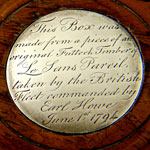A 1794 Battle of the Glorious First of June Snuffbox made from the timber of H.M.S. Sans Pareil
Adding product to your cart
Diameter: 9cm (3.5in)
Turned oak box with the cover applied with a silver plaque engraved 'This box was made from a piece of an original Futtock Timber of Le Sans Pareil taken by the British fleet commanded by Earl Howe, June 1st: 1794'. Futtock timbers compose the frame of the ship. There are usually four futtocks (component parts of the rib) to a ship. The word itself is derived from a contraction of 'foot hook', indicating their role in providing a secure framework to a ship.
Ex: Earl Spencer, Althorp, Northampton
Read more
The French Tonnant-class 80-gun ship Sans Pareil was built at Brest and launched in 1793. In May 1794 she was the flagship of Rear-Admiral Joseph-Marie Nielly and sent to meet a corn convoy inbound from North America. Neilly initially failed to make contact with the convoy, but on 9 May 1794 his squadron came across a British one, escorted by H.M.S. Castor under the command of Captain Thomas Troubridge. The squadron attacked and captured the Castor, and a number of the convoy's ships, but Castor was only briefly in French hands, being retaken by H.M.S. Carysfort on 29 May.
Having made contact with the approaching convoy, Nielly’s squadron began the return voyage. During this, a French fleet under Admiral Villaret de Joyeuse was intercepted by a British fleet under Earl Howe, and a series of sporadic actions were fought on 28 and 29 May. Neilly brought some of his larger ships, including the Sans Pareil to join Villaret, sending the convoy on ahead escorted by frigates. The fleets eventually clashed in force at the Battle of the Glorious First of June (so-called because it was fought so far out into the Atlantic). During the battle H.M.S. Royal George, the flagship of Vice-Admiral Alexander Hood, broke the French line ahead of Sans Pareil, bringing down her fore and mizzen masts with a broadside. H.M.S. Glory then passed across her stern, shooting away her main mast. Disabled and unmanageable, Sans Pareil drifted out of the French line and was taken by H.M.S. Majestic. Aboard her were found Troubridge and 50 men and officers of the Castor.
The Sans Pareil was afterwards commissioned into the Royal Navy, and was initially commanded from March 1795 by Captain Lord Hugh Seymour who later used her as his flagship. On 22 June 1795 Sans Pareil was present as part of a fleet under Admiral Hood at the Battle of Groix where she engaged the French ships Formidable and Peuple, losing ten killed, and having another two wounded before the Formidable was captured. Sans Pareil continued to sail off the French coast, using her French build to her advantage by flying the French ensign and luring privateers to within range before taking them as prizes.
Seymour contracted a fever and died on 11 September 1801 after which Sans Pareil returned to Plymouth in need of repair. The subsequent refit turned her into a hulk for French prisoners-of-war. She was later reduced to a sheer hulk at Plymouth in October 1810, and spent another 32 years in service before being finally broken up in October 1842.




